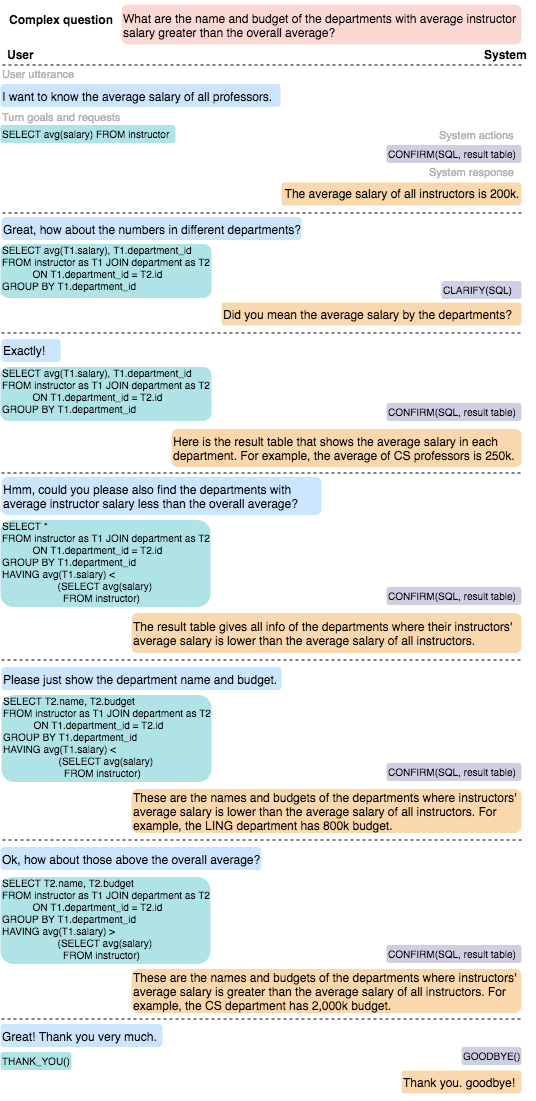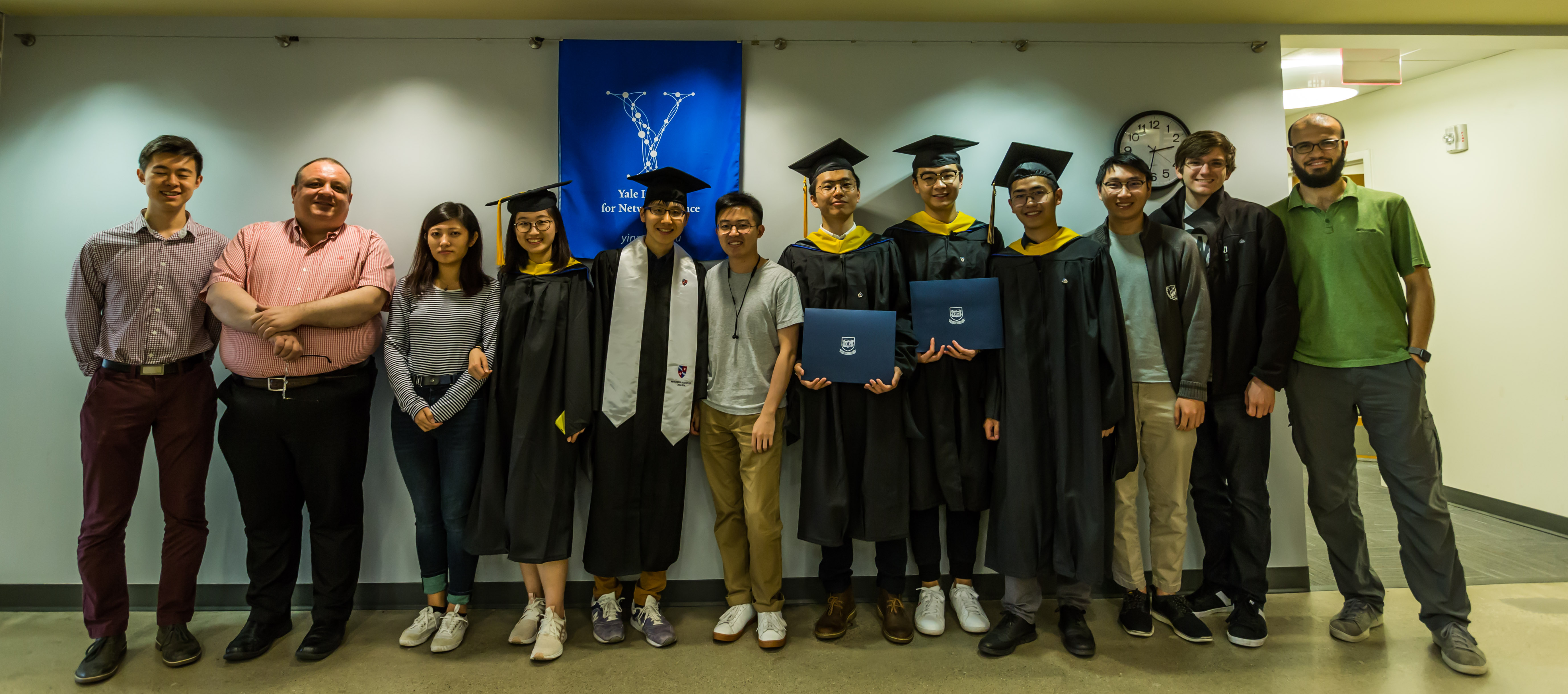
 CoSQL
1.0
CoSQL
1.0


Nov 12, 2024: We have released Spider 2.0 full paper, data and code. Follow the guideline to submit your scores to the leaderboard!
Aug 28, 2024: The early access version of Spider 2.0 (a more realistic and challenging text-to-SQL task) is now available! We expect to release the whole dataset in 1-2 weeks. As this is a preliminary release, there may be errors. Your feedback would be invaluable in refining the dataset!


INFORM_SQL label given the interaction context and the DB schema. Comparing to other context-dependent text-to-SQL tasks such as SParC, the DST task in CoSQL also includes the ambiguous questions if the user affirms the system clarification of them. In this case, the system clarification is also given as part of the interaction context to predict the SQL query corresponding to the question. As in Spider and SParC tasks, we report results of Exact Set Match without Values:
| Rank | Model | Question Match | Interaction Match |
|---|---|---|---|
|
1 Feb 14, 2022 |
STAR
Alibaba DAMO & SIAT (Cai and Li et al., EMNLP-Findings '22) code demo |
57.8 | 28.2 |
|
2 Apr 2, 2022 |
CQR-SQL
Tencent Cloud Xiaowei (Xiao et al.,'22) |
58.3 | 27.4 |
|
3 Jun 4, 2022 |
RASAT + PICARD
SJTU LUMIA & Netmind.AI (Qi et al., EMNLP'22) code |
55.7 | 26.5 |
|
4 Dec 26, 2022 |
MT Training + N-best List Rerankers + PICARD
Alexa AI (Parthasarathi et al., ICASSP'23) |
55.8 | 24.8 |
|
5 Oct 5, 2021 |
HIE-SQL + GraPPa
Alibaba DAMO (Zheng et al. ACL-Findings '22) |
53.9 | 24.6 |
|
6 Jul 14, 2021 |
T5-3B+PICARD
Element AI, a ServiceNow company (Scholak et al., EMNLP'21) code |
54.6 | 23.7 |
|
7 Jan 7, 2022 |
RATSQL++ + ELECTRA
Anonymous |
53.8 | 22.1 |
|
8 Sep. 21, 2020 |
RAT-SQL + SCoRe
Yale & Microsoft Research & PSU (Yu et al. ICLR '21) |
51.6 | 21.2 |
|
9 Aug 24, 2020 |
R²SQL + BERT
Alibaba DAMO (Hui et al. AAAI '21) code |
46.8 | 17.0 |
|
10 Jan 26, 2021 |
IST-SQL + BERT
University of Science and Technology of China (Wang et al. AAAI '21) code |
41.8 | 15.2 |
|
11 Nov. 16, 2020 |
WaveSQL + BERT
Anonymous |
46.1 | 15.1 |
|
12 May 26, 2020 |
IGSQL + BERT
Peking University (Cai et al. EMNLP '20) code |
42.5 | 15.0 |
|
13 Aug 30, 2019 |
EditSQL + BERT
Yale University & Salesforce Research (Zhang et al. EMNLP '19) code |
40.8 | 13.7 |
|
14 May 21, 2020 |
GAZP + BERT
University of Washington & Facebook AI Research (Zhong et al., EMNLP '20) |
39.7 | 12.8 |
|
15 Apr 21, 2021 |
MemCE
UoE (Jain et al., TACL '21) |
28.4 | 6.2 |
|
16 Aug 30, 2019 |
CD-Seq2Seq
Yale University & Salesforce Research (Yu et al. EMNLP '19) code |
13.9 | 2.6 |
|
17 Aug 30, 2019 |
SyntaxSQL-con
Yale University (Yu et al. EMNLP '18) code |
14.1 | 2.2 |
| Rank | Model | Question Match | Interaction Match |
|---|---|---|---|
|
1 Jun 4, 2022 |
RASAT + PICARD
SJTU LUMIA & Netmind.AI (Qi et al., EMNLP'22) code |
66.3 | 37.4 |
|
2 May 21, 2020 |
GAZP + BERT
University of Washington & Facebook AI Research (Zhong et al., EMNLP '20) |
35.9 | 8.4 |
INFORM_SQL. It considers a SQL query, the execution result, and the DB schema. Preserving logical consistency (Logic Correctness Rate (LCR)) between SQL and NL response is crucial in this task, in addition to naturalness and syntactical correctness.
| Rank | Model | BLEU | Grammar | LCR (%) |
|---|---|---|---|---|
|
1 Dec 15, 2022 |
Complexity Aware Prompts + T5
Alexa AI |
28.1 | - | - |
|
2 Aug 30, 2019 |
Template baseline | 9.3 | 4.0 | 41.0 |
|
3 Aug 30, 2019 |
Pointer-generator baseline | 15.1 | 3.6 | 35.0 |
|
4 Aug 30, 2019 |
Seq2Seq baseline | 14.1 | 3.5 | 27.0 |
INFORM_SQL.
| Rank | Model | Accuracy |
|---|---|---|
|
1 Dec 20, 2019 |
UTran-SQL | 87.2 |
|
2 Aug 30, 2019 |
TBCNN-pair baseline | 83.9 |
|
3 Aug 30, 2019 |
Majority baseline | 62.8 |